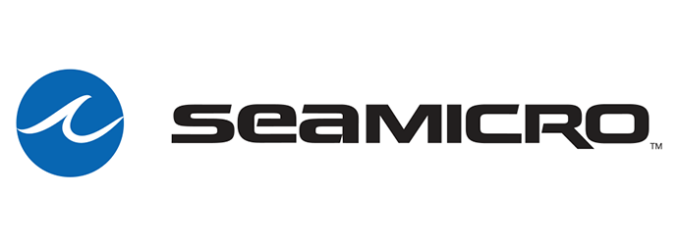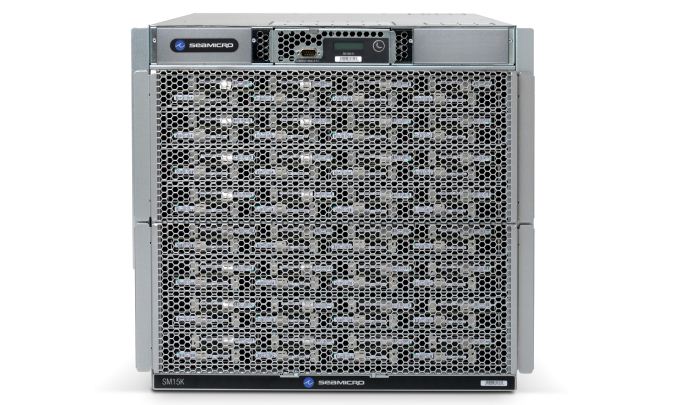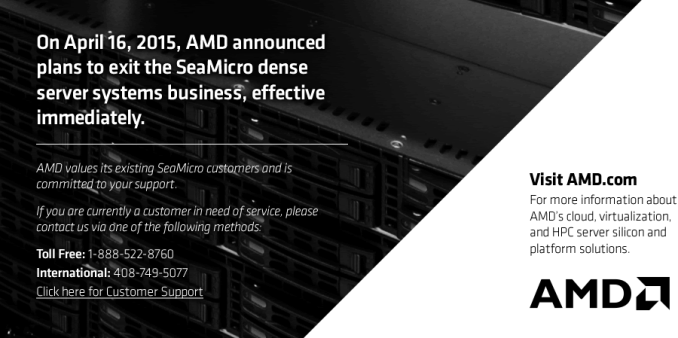AMD Exits Dense Microserver Business, Ends SeaMicro Brand
by Ryan Smith on April 16, 2015 5:30 PM EST- Posted in
- CPUs
- IT Computing
- AMD
- SeaMicro
- Microserver
- Servers

AMD’s Q1’15 earnings announcement just came out a bit ago, and while we’re still waiting for the analyst call to take place to get more details, there is one item we want to get to right away, and that’s the fate of AMD’s dense server business. As part of today’s earnings release, AMD has announced that they’re existing the dense server system business – operating under the SeaMicro brand – effective immediately.
AMD initially acquired SeaMicro back in 2012 for $334 million as part of their larger play into being an agile company, aiming to take a big chunk of what was expected to be a fast-growing market micro/dense server market. In the microserver model, servers are built using very large numbers of lower performance cores, making the servers leaner, more power efficient systems for tasks that involve large numbers of low-impact threads (think: web servers). This in turn mapped well to AMD’s processor designs, where both the Bulldozer and Cat families would be well suited for such a design, not to mention AMD’s future ARM based CPUs.
SeaMicro’s first product post-acquisition was the SM15000, a dense server design announced in late 2012 that offered either AMD “Piledriver” Opterons or Intel “Ivy Bridge” Xeon CPUs. However as it turns out that first design was also the last design; SeaMicro did not release any additional products prior to today’s announcement from AMD.
Jumping back to today, AMD’s announcement comes as the company is continuing to try to find a solid foothold as a semi-custom silicon company, to which it would appear that the SeaMicro business no longer fits into. AMD’s initial announcement does offer a bit of insight as to why they’re exiting the business – to “sharpen and simplify” what the company invests in – and we’ll likely hear more on today’s call.
Meanwhile it’s worth noting that we haven’t heard anything from SeaMicro in some time now, so today’s announcement is perhaps not all that surprising. Still, AMD’s first ARM processors were set to ship this year – the Opteron A1100 – which would have been a good fit for the SeaMicro servers. However A1100 itself appears to be behind schedule at this time, as AMD has yet to bring A1100 to market beyond last year’s development kit.
Anyhow, as part of exiting the dense server business, AMD will be taking a $75 million dollar special charge, which is “primarily related to impairment of previously acquired intangible assets” and will include a $7 million cash payment. Meanwhile AMD’s announcement doesn’t say what will become of the SeaMicro team – at this point we’re not entirely sure how large it is after AMD’s most recent restructuring – though I wouldn’t be surprised if they at least rolled some of that expertise into future ARM server CPUs. As for the SeaMicro brand itself, with AMD’s exit the brand has been shuttered, and AMD has deactivated the SeaMicro website.
Update: Here are the prepared remarks from AMD's CFO regarding SeaMicro
At the corporate level, we continue aligning larger portions of our R&D investments to take advantage of long-term growth opportunities across our EESC segment. As we prioritize our R&D investments and simplify our business, we made the decision in the first quarter to exit the dense server systems business as we increase investments in our server processor development. We retain the fabric technology as a part of our overall IP portfolio. We see very strong opportunities for next-generation, high-performance x86 and ARM processors for the enterprise, datacenter, and infrastructure markets and we will continue to invest strongly in these areas.












60 Comments
View All Comments
siberus - Saturday, April 18, 2015 - link
Intel actually announced the p4 extreme edition "gallatin" a week before amd released the athlon fx line in a move many agree was a bid to steal amd's thunder. The fx 51 was released at $733 according to an old anand article and the p4 extreme was released at $999 according to wikipedia.JonnyDough - Tuesday, April 21, 2015 - link
I'd have taken the FX-51 any day of the week. I have owned just about every chip between the single core Athlon 3000+ to the FX-60/Opty 185 for 939 and I'd still take an Opty 165 over a dual core Pentium D any day of the week.JonnyDough - Tuesday, April 21, 2015 - link
Intel couldn't compete with AMD's mid ranged CPUs, let alone their flagship CPU. Intel's flagship Pentium 4 was sold for more cost than AMD's matching Athlon - a low end 2.0ghz dual core I believe. You were obviously deluded at the time.JonnyDough - Tuesday, April 21, 2015 - link
AMD had to charge higher prices. They were still selling a lot less chips than the Pentium 4 was, because of Intel's anti-competitive practices, which AMD sued for. Economies of scale wasn't in AMD's favor at the time, and their chips were a LOT better.AMD has been keeping Intel's prices low, and the recent gains in overall efficiency and power for CPUs is much less today than it was during previous years. There is less and less reason to upgrade, so to entice buyers the prices have to be lower.
chizow - Thursday, April 16, 2015 - link
Just add it to a laundry list of poor executive decisions, poor vision, poor management of limited funds. Many questioned this move when it happened, and as usual AMD's anti-Midas touch has turned this questionable acquisition into a steaming pile of poop just a few short years later.Of course the bigger problem is this casts a huge shadow of doubt over AMD's entire ARM strategy, as their backers and proponents kept insisting AMD would dominate this micro server market with their ARM-based Zen designs. Now, you have to ask why bother with ARM at all if there's not a vertical market in place for AMD's ARM chips.
ravyne - Thursday, April 16, 2015 - link
The IT landscape has changed pretty drastically -- Microservers were a reaction to Virtual Machine overhead that technologies like LXC, Windows Containers, and Docker have obsoleted. Its more efficient now to run many containers on one fat host than yo split them across many tiny physical servers. If rumors are true about Zen's architecture (which essential allows for running many light threads on a core with dedicated resources each, or alternatively fewer heavy threads faster by hanging those resources together) then it will be a good fit for container technologies but an antithetical fit for micro-servers. I'm sure they got some good IP and people, but it was a good bet that didn't age well, and its better to cut it loose than to hold on without a market. As to why they didn't sell it, I suspect that the rest of the world realized what I just wrote, too, and there's not much value left after taking the IP and people out if it.bleh0 - Thursday, April 16, 2015 - link
Someone needs to buy AMD or just purchase their IPs.Gigaplex - Thursday, April 16, 2015 - link
It wouldn't surprise me if NVIDIA stepped up to the plate. They've been after an x86 license for a long time, and it would knock out their main GPU competitor at the same time.TheinsanegamerN - Thursday, April 16, 2015 - link
best case scenario, intel buys their gpu tech, and nvidia buys the x86 tech. nvidia gets the x86 license from intel, intel continues the radeon line, and we have two healthy x86 and gpu vendors again. and the death on intel hd graphics YAY!Krysto - Friday, April 17, 2015 - link
Or even better, Samsung or Qualcomm buys AMD, and actually becomes a strong competitor to Intel.